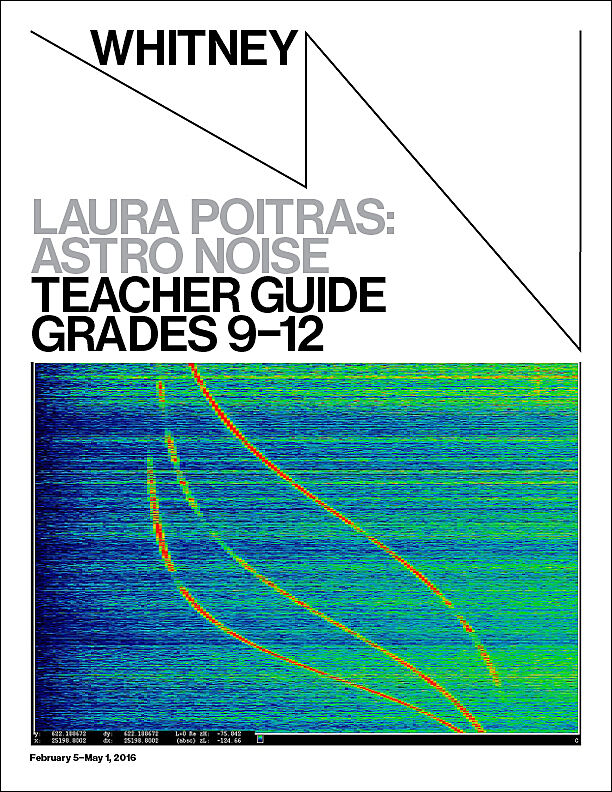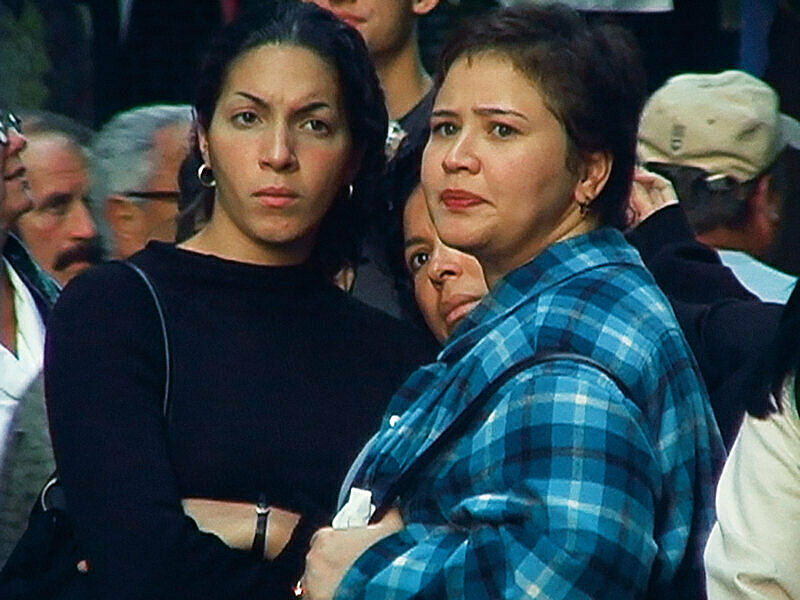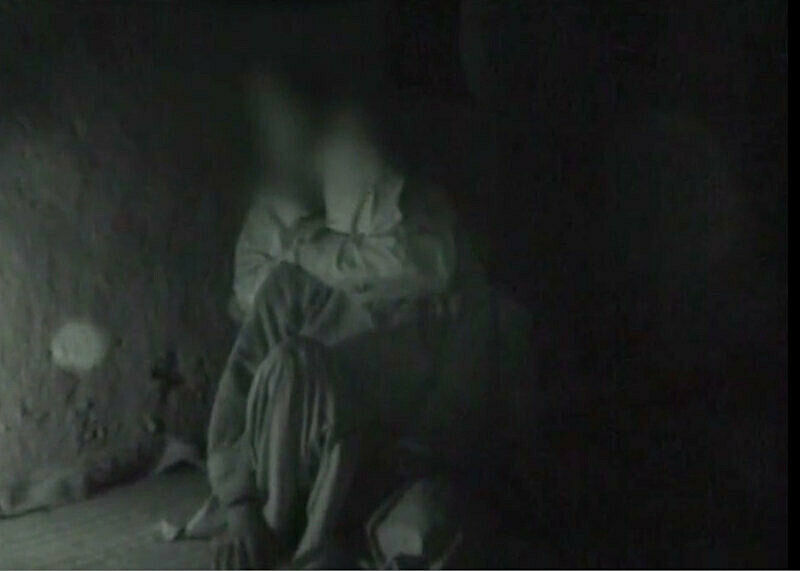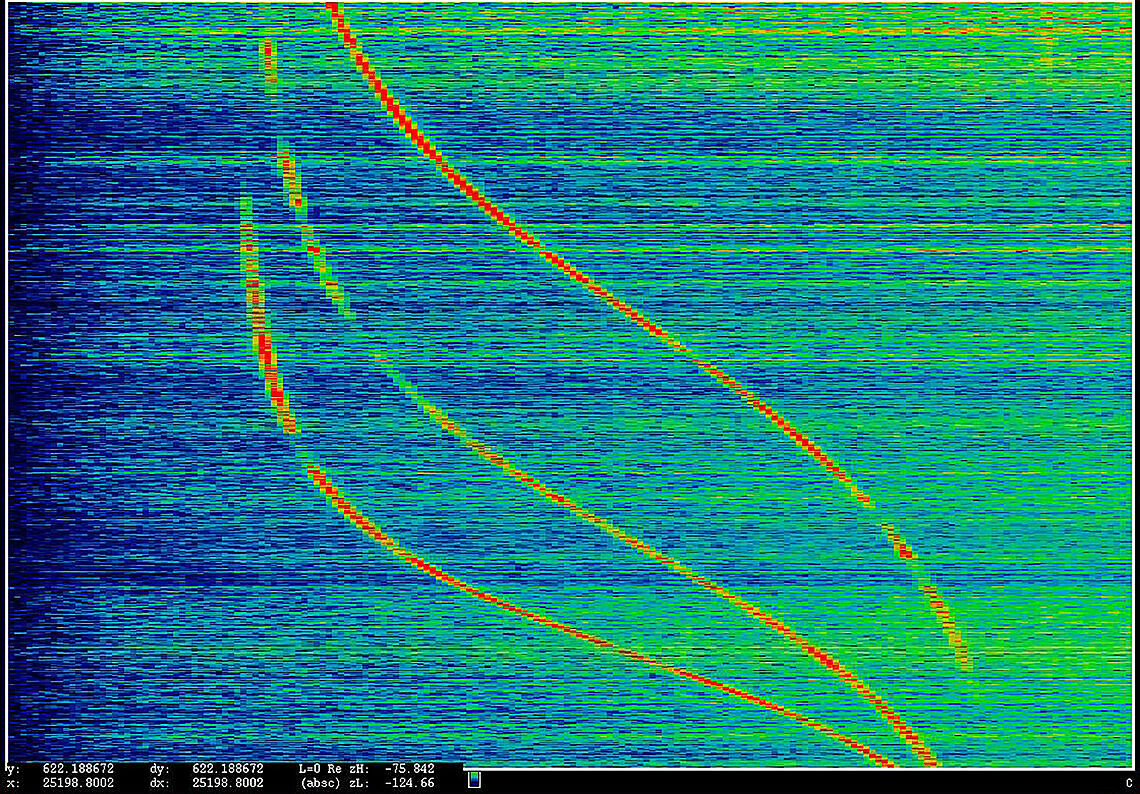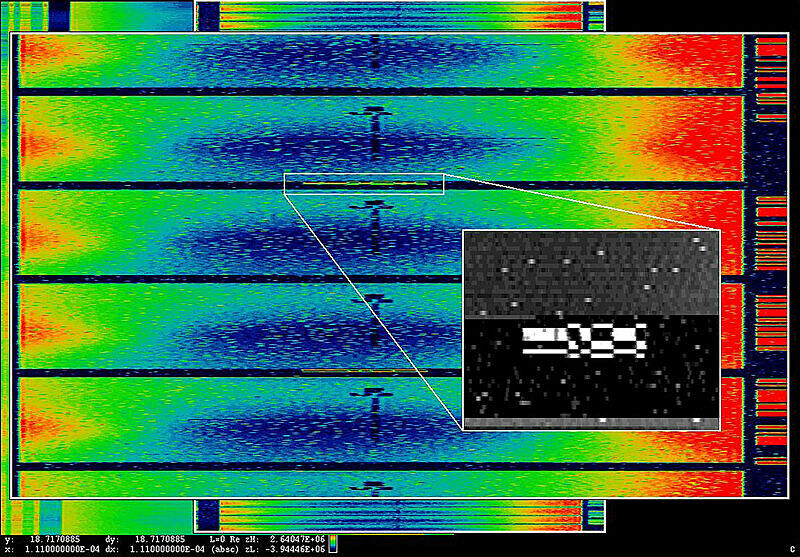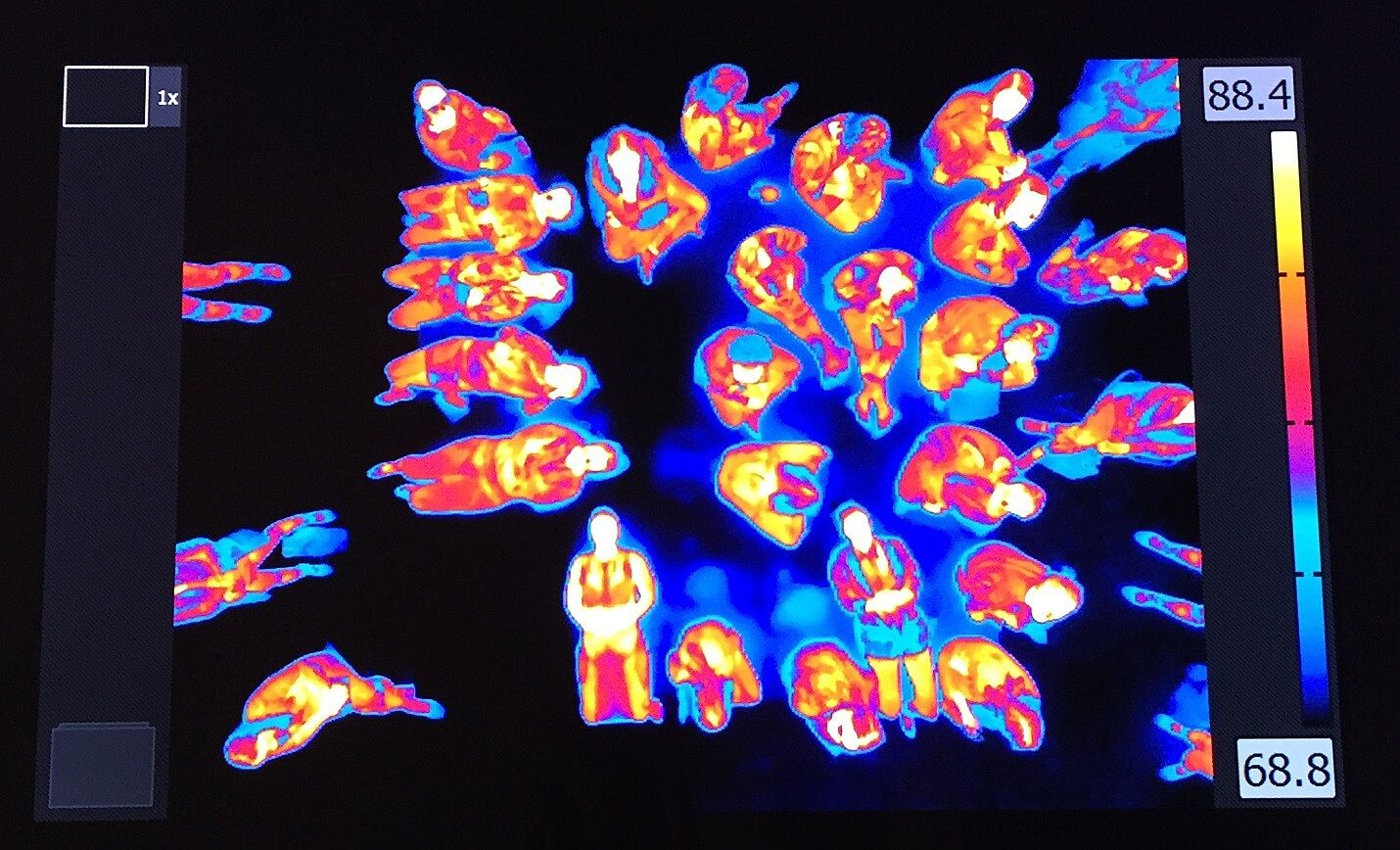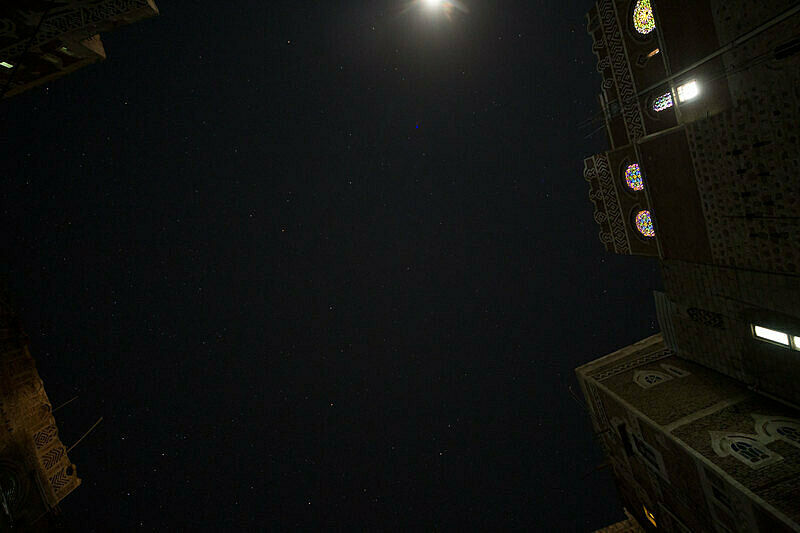Teacher Guide:
Laura Poitras: Astro Noise
Feb 5, 2016
WELCOME TO THE WHITNEY!
Dear Teachers,
We are delighted to welcome you to the exhibition, Laura Poitras: Astro Noise, on view at the Whitney from February 5 through May 1, 2016. For the exhibition, artist, filmmaker, and journalist Laura Poitras has created an interrelated series of installations in the Museum’s eighth-floor galleries.
The exhibition expands on Poitras’s project to document post-9/11 America, engaging visitors in formats outside her non-fiction filmmaking. Her immersive environments incorporate documentary footage, architectural interventions, primary documents, and narrative structures, inviting visitors to interact with the material in strikingly intimate and direct ways.
When you and your students visit the exhibition, you will see a selection of works that build on topics important to Poitras, including mass surveillance, the war on terror, the U.S. drone program, Guantánamo Bay Prison, occupation, and torture. Because these topics are challenging, we are recommending the exhibition for high school students only. Any school that wishes to visit the exhibition must participate in a two-part program. The first part will be a visit to your classroom by a Whitney Educator, who will introduce your students to some of the issues and ideas in the exhibition. The second part will consist of a seventy-minute Guided Visit at the Museum on a Tuesday when the Whitney is closed to the public.
This guide provides a framework for preparing you and your students for the two-part program described above. It also offers suggestions for follow up classroom reflection and lessons. The discussions and activities introduce some of the exhibition’s key themes and concepts. These materials have been written specifically for High School students. We encourage you to adapt and build upon them in order to meet your teaching objectives and students’ needs.
We look forward to delving deeply into this subject matter with you and your students. This program is FREE for NYC Public Schools, and we are accepting reservations from February 5–May 1, 2016. Museum visits to the exhibition will be on Tuesdays only. For more information or to sign up, visit /education/schools-educators/k-12.
We hope to see you this spring and we look forward to welcoming you and your students at the Museum.
The School and Educator Programs team at the Whitney
LAURA POITRAS: ASTRO NOISE
When I make films, I witness and record moments of uncertainty that unfold in real time. The future is unknown, often full of risk for the people I document. When I edit those moments months or years later; the future has transpired and the uncertainty is transformed into a plot: a narrative in which decisions that were vast and multiple are reduced to one—the path taken, not the many paths untaken. But the drama, the life pulse of any story, lies in the uncertainty of the moment, the choices, doubts, fears, desires, and risks of how to act and act again.
—Laura Poitras, Berlin Journal, 2012
Through her work in art, film, and journalism, Laura Poitras has emerged as one of the most thoughtful and impassioned voices discussing the complex realities of the post-9/11 world. In the months following September 11, 2001, political and military officials instigated significant changes in U.S. policy, expanding the use of indefinite detention, secret renditions, targeted killings, torture, and mass electronic surveillance. The “war on terror,” as these strategies are collectively known today, is often obscured from many Americans’ daily lives. Poitras has worked to communicate its complexities primarily through her celebrated 9/11 Trilogy of feature-length documentary films. In Astro Noise, her first solo museum exhibition, she expands her cinematic practice into a series of installations and immersive media environments.
A decade ago, in response to the United States invasion of Iraq, Poitras embarked on her powerful “9/11 Trilogy,” three feature-length documentary films. The first of these, My Country, My Country (2006), follows the family of an Iraqi doctor during the United States occupation. The Oath (2010) weaves together the story of two men involved with Al Qaeda and the larger issues surrounding the U.S. prison at Guántanamo Bay in Cuba. Finally, the Oscar-winning CITIZENFOUR (2014) details Poitras’s meetings with whistleblower Edward Snowden as he revealed the massive scale of the National Security Agency’s global surveillance programs. Collectively in these works, Poitras investigates the strategies and tactics developed in the aftermath of 9/11 that have come to be known as the “war on terror”: ground wars in Afghanistan, Iraq, and elsewhere; torture; mass and warrantless surveillance; and the use of drones in what officials call “targeted killing.”
As she worked on CITIZENFOUR, Poitras became interested in making installation based work. The vast, often invisible networks and infrastructures of power that she was trying to reveal in that film, she realized, might also be vividly expressed in physical space, and thus made direct and palpable for the viewer. Astro Noise, the title of the resulting exhibition, comes from the name of an encrypted file Snowden sent to Poitras, which ultimately led to the events detailed in CITIZENFOUR. The phrase also refers to the oldest light in the universe, microwaves detected by astronomers in the 1960s and later theorized to be some of the best evidence for the big bang. These multiple meanings, each existing on a different scale, are apt frames for the experience of moving through the immersive, room-size installations that comprise the exhibition.
Like Poitras’s films, each installation in the exhibition employs narrative and documentary elements. While the moviegoer is a passive spectator, the visitor to Astro Noise becomes the protagonist of each scenario, deciding how deeply to engage with the ethical dilemmas Poitras raises. By working on this directed, bodily level, she asks viewers to actively consider their position and responsibility in the “war on terror.”
The exhibition, Laura Poitras: Astro Noise is organized by Jay Sanders, Curator and Curator of Performance. It continues the Museum’s involvement with Poitras, whose work was included in the 2012 Whitney Biennial exhibition. Sanders, who also co-organized the 2012 Biennial, said, “Laura Poitras compels us to rethink the potential for an artist to explore and convey the nature of power and to affect understanding and responsibility in the larger world. Astro Noise sees her reconsidering the moving image toward other ways of addressing and engaging an audience, presenting the culture and mechanisms of surveillance and the war on terror in a very different way, through structured visual experiences that provide much more than information and compel an audience to enter into a visceral experience.”
About Laura Poitras
Laura Poitras is a filmmaker, journalist, and artist. Born in Boston, Massachusetts, Poitras worked as a chef when she left high school and then studied filmmaking at San Francisco Art Institute. In 1992, she moved to New York to study political theory and documentary filmmaking at the New School for Social Research.
In 2004, Poitras traveled to Iraq to document the war, working in a conflict zone for the first time. At Abu Ghraib, just weeks after the prisoner abuse photographs were publicized, exposing prisoner abuse by the U.S. military and the Central Intelligence Agency (CIA), she filmed an inspection of the prison led by doctor Riyadh al-Adhadh, who later invited her to document his medical clinic.
Embedded with a U.S. Civil Affairs unit and with unique access that included the United Nations and private security contractors, she spent eight months in Baghdad documenting the occupation and election process.
After releasing the film, My Country, My Country in 2006, the United States government placed Poitras on a secret watchlist, and, through 2012, she was detained and interrogated at the U.S. border each time she traveled internationally. To protect her film footage from being seized, she relocated to Berlin in 2012. Poitras began work on a documentary about surveillance in 2011, focusing on National Security Agency (NSA) whistleblowers William Binney and Thomas Drake, as well as Julian Assange and Tor developer Jacob Appelbaum. Tor is free software for enabling anonymous communication. Tor directs Internet traffic through a free, worldwide, volunteer network consisting of more than 7,000 relays to conceal a user’s location and usage from anyone conducting network surveillance or traffic analysis. Using Tor makes it more difficult for Internet activity to be traced back to the user. This includes visits to websites, online posts, instant messages, and other communication forms. More information about Tor: https://en.wikipedia.org/wiki/Tor_(anonymity_network). In August 2012 Poitras produced a short film for The New York Times about Binney and Stellar Wind, one of NSA’s wiretapping programs. More information about Stellar Wind: http://www.nytimes.com/2015/04/25/us/politics/value-of-nsa-warrantless-spying-is-doubted-in-declassified-reports.html
In January 2013, Poitras received the first encrypted email from Edward Snowden who used the alias, “CITIZENFOUR.” After five months of correspondence, she traveled to Hong Kong to meet Snowden with lawyer, journalist, and author, Glenn Greenwald. Her video from Hong Kong of Snowden revealing his identity was broadcast worldwide.
Poitras has taught filmmaking at Yale and Duke Universities, and is on the board of the Freedom of the Press Foundation. Along with AJ Schnack and Charlotte Cook, she is co-creator of Field of Vision, a visual journalism film unit. Poitras has received many honors for her work, including a MacArthur Fellowship, Guggenheim Fellowship, and a Peabody Award. Poitras’s reporting on NSA mass surveillance based on Snowden’s disclosures won the George Polk Award for national security journalism, and shared in the 2014 Pulitzer Prize for Public Service.
Sources
Laura Poitras and Jay Sanders, editors. Astro Noise: A Survival Guide for Living Under Total Surveillance. Whitney Museum of American Art and Yale University Press, 2016.
Exhibition brochure and wall text, Whitney Museum of American Art, 2015.
Praxis Films/Laura Poitras’s website.
More about the exhibition
Pre-visit Activities
Before a Whitney Educator visits your classroom, we recommend that you and your students explore and discuss some of the ideas and topics in the exhibition.
Objectives:
- Introduce students to selected topics in the work of Laura Poitras and some of the topics they may discuss with a Whitney Educator in the classroom.
- Explore ideas about surveillance in students’ daily lives.
ARTIST AS STORYTELLER
Gray
When you visit the exhibition, you and your students will see Poitras’s installation O’Say Can You See, 2001/2016, a double video projection on a two-sided screen. One side presents a short film depicting slow-motion shots of people gazing at the unseen remains of the World Trade Center in the days following the 9/11 attacks. Also titled O’Say Can You See, it was originally shown in 2011 and is the only aspect of works on view that was not made specifically for the exhibition. Over these visuals plays a haunting audio track: the national anthem, altered and looped by Poitras, as it was performed at New York’s Yankee Stadium during Game 4 of the 2001 World Series on October 31, 2001.
a. Use these resources with your students to discuss the events of 9/11 and its aftermath.
http://timeline.911memorial.org/#Timeline/2
9/11 memorial website’s interactive timeline of the September 11, 2001 attacks.
http://ww2.kqed.org/lowdown/2014/09/10/13-years-later-four-major-lasting-impacts-of-911/
KQ Education article about the lasting impact of 9/11.
b. With your students, view and discuss Laura Poitras’s short film, O’ Say Can You See, 2001 on her website: http://www.praxisfilms.org/shorts/
Ask students to imagine what the people are looking at and what emotions they might be feeling. How would students describe the expressions on people’s faces?
Why do students think Laura Poitras filmed the responses of the people looking at the site rather than the ruins of the World Trade Center itself?
In the installation, you’ll have a different viewing experience. The other side of the large-scale screen presents U.S. military video of the interrogations of two prisoners in Afghanistan, also taking place in the months immediately following the 9/11 attacks. One of the prisoners is Salim Hamdan, Osama bin Laden’s driver, whose trial was detailed in Poitras’s 2010 film The Oath. By juxtaposing scenes of people at Ground Zero with military interrogation footage, O’Say Can You See situates viewers in the direct aftermath of 9/11. “These faces capture a moment in history at a crossroads,” says Poitras, Many different paths could have been taken. Fifteen years later we’re now seeing the unintended consequences of the choices we made.”
c. When you and your students visit the exhibition, compare watching the film in your classroom to your experience of seeing it on a large screen. What immediate differences do students notice? What happens when they move through the installation space to the screen on the other side? In what ways does the double screen change the meaning and impact of both films? How do students understand both films differently in the context of the installation?
ARTIST AS CRITIC
POST-9/11 AMERICA
Laura Poitras’s work documents and addresses the expansion of the security state and the issues that certain government policies and procedures raise in post-9/11 America. The American Civil Liberties Union (ACLU) also addresses these issues in their paper, A Call To Courage, Reclaiming Our Liberties Ten Years After 9/11, (2011).
The ACLU notes that since 9/11, the United States has engaged in “policies of torture and targeted killing, extraordinary rendition and wiretaps, military commissions and indefinite detention, political surveillance and religious discrimination.” Some of these policies have been stopped, but most of them—including warrantless surveillance and racial profiling—remain part of the U.S. national security strategy today, as well as a pervasive politics of fear.
“. . .our nation still faces the challenge of remaining both safe and free. Our choice is not, as some would have it, between safety and freedom, just the opposite is true.”
https://www.aclu.org/files/assets/acalltocourage.pdf
American Civil Liberties Union (ACLU) A Call To Courage, Reclaiming Our Liberties Ten Years After 9/11, 2011, 4.
With your students, use the quotation above and the ACLU’s paper https://www.aclu.org/files/assets/acalltocourage.pdf to research and discuss the challenges of safety and freedom in the United States today.
What effect do safety and security policies and procedures have on students in their daily lives? For example: mandatory security checks, metal detectors, backpack checks on the subway, and stop and frisk tactics by the police.
How do they affect your school?
What impact do they have on students’ neighborhoods or communities?
On a national level?
ARTIST AS CRITIC
UNDER SURVEILLANCE
I actually think everybody has something to hide. And that people who say that they don’t aren’t really confronting the question. If I said, “I want to set up a camera in your bathroom . . .”Right? Or, “I want to set up a camera in your bedroom.” Or, “I want to turn on the camera that’s on your laptop.” Is that OK with you? Is that OK? Say the government says, “We want to turn on all of those cameras that all of us have on our laptops. We’ll have them on so that the government can make sure that we’re all safe.” How do you think people would respond?
—Laura Poitras
http://www.vogue.com/2865709/laura-poitras-edward-snowden-documentary-citzenfour/
Vogue interview with Laura Poitras about her film, Citizenfour, (2014).
One of the main topics of the exhibition is surveillance and the increasing erosion of our personal privacy, which is continually compromised by security checks, surveillance, and the collection of phone conversations by the National Security agency (NSA). Ask your students to discuss Laura Poitras’s quotation above and their own experiences of surveillance.
What types of surveillance are students aware of?
Is there video surveillance at their school?
Where do they notice being watched?
Do students think surveillance is beneficial? Why or why not?
How is our privacy compromised by surveillance?
How much and what types of security do we need to keep us safe?
Artist as Observer
INVASION OF PRIVACY
The ability of technology to capture information and erode our personal privacy has increased as our digital devices have become more sophisiticated. For example, the devices that we carry can track us on social media or gps and gather biometric data such as our fingerprints. With your students, explore the various ways in which we can see and be seen in the digital world today. Discuss how students’ interactions on the Internet or social media might affect their privacy. Consider the following:
What is being collected?
How is it used?
How is data stored?
Who has access to it?
Does data expire? When and how?
When do students notice that they are being tracked or spied upon by cookies, retailers, Facebook, Google, or other search engines?
What do they notice when they use gps on their phones or post an image or a video to Instagram?
What type of advertisements or messages appear when they check their email?
Who sees the information they search for or post?
Do students edit what they share? How?
ARTIST AS CRITIC
DRONE’S EYE VIEW
ANARCHIST is a series of images that Laura Poitras has drawn from the documents provided to her by National Security Agency whistleblower Edward Snowden. They display signals collected through an eponymous top-secret operation run by the Government Communications Headquarters (GCHQ), the United Kingdom’s surveillance agency. From the top of the Troodos Mountains on the island nation of Cyprus, two antennae operating twenty-four hours a day intercept signals from satellites, drones, and radars in the Mediterranean region. The images in ANARCHIST show various stages in the process of descrambling the collected signals.
a. Ask your students to use these resources to research and discuss the Anarchist operation. https://theintercept.com/2016/01/28/hacked-images-from-israels-drone-fleet/
https://theintercept.com/2016/01/28/israeli-drone-feeds-hacked-by-british-and-american-intelligence/
http://www.theguardian.com/world/2016/jan/29/snowden-files-us-uk-spied-feeds-israeli-drones-jets
Do students think it is in the public’s interest to report this story? Why or why not?
Ask students to compare the written information with the images. How do the words and the visual representations inform their understanding of the Anarchist operation differently?
b. The Bill of Rights Fourth Amendment to the United States Constitution is intended to protect people from unreasonable searches and seizures by the government. The Fourth Amendment has been debated frequently during the last several years as police and intelligence agencies in the United States have engaged in a number of secret, controversial surveillance activities. For example, the National Security Agency has collected Americans’ telephone and Internet data as part of the “war on terror.” There is also concern about the use of aerial surveillance by piloted aircraft or drones like those in the Anarchist operation. Ask students to read and discuss the Fourth Amendment:
http://constitutioncenter.org/interactive-constitution/amendments/amendment-iv
The Fourth Amendment was written 300 years ago. Does it still protect our personal privacy today?
How would students change the Fourth Amendment to address privacy issues raised by contemporary surveillance, the Internet, digital devices, and drones?
ARTIST AS STORYTELLER
NOT SECRET ANYMORE
Since June 2013, Laura Poitras has reported extensively on the National Security Agency (NSA) and Edward Snowden’s disclosures. Her NSA reporting has been published in The Guardian, The New York Times, The Washington Post, Der Spiegel, The Intercept, and shared in the 2014 Pulitzer Prize for Public Service. Find Laura Poitra’s NSA reporting on her website:
http://www.praxisfilms.org/nsa-reporting/.
a. With your students, view and discuss this interview, filmed by Laura Poitras, in which Edward Snowden talks to lawyer, journalist, and author Glenn Greenwald about his motives to leak NSA intelligence: http://www.theguardian.com/world/video/2013/jun/09/nsa-whistleblower-edward-snowden-interview-video
b. By leaking NSA information , Snowden revealed that the United States government was acting illegally according to the Fourth Amendment. In response to the interview question: “Do you view Edward Snowden as a hero? The film [CITIZENFOUR) seems to suggest that you do.” for the Hollywood Blog for The New York Times, Poitras said:
A lot of people have asked me that, and it’s a question I have tried not to answer. It’s a bit reductive, and I’ve tried not to make a reductive film. So I guess what I’d say is that I’m interested not just in him but people taking the risk of whistleblowing and to sacrifice their own personal freedom for something larger. I have no doubt that what he did was motivated by the fact that he profoundly believes that the public has a right to know these things and that the intelligence agencies have grown out of control. Generally, in the type of filmmaking I do, I’m interested in actions rather than descriptions. So I would describe what he did as heroic.
—Laura Poitras
http://carpetbagger.blogs.nytimes.com/2015/01/28/laura-poitras-on-heroic-acts-not-heroes/?_r=1
Ask your students to discuss Poitras’s response and use the following resources to research different views of Snowden and his actions. Ask students to consider who gets to decide what is public or private information. Ask them to debate Snowden’s actions and the risks he took. For example, discuss his actions in terms of choice, risk, conscience, heroism, patriotism, loyalty, rights, freedom, sacrifices, secrecy, accountability, responsibility.
http://www.newyorker.com/news/john-cassidy/why-edward-snowden-is-a-hero
http://www.democracynow.org/2015/10/14/is_snowden_a_hero_or_traitor
http://www.theguardian.com/commentisfree/2015/jun/14/edward-snowden-hero-government-scare-tactics
ARTIST AS STORYTELLER
1984
I’m at the point in 1984 where they rent the room: Winston sees the rat. The book is terrifying and so relevant to today. The fear of an all-knowing state. Doublespeak. Reading the newspaper about kill lists. For what? The “enemy” does not threaten to destroy us. It is just being used to justify a growing surveillance state.”
—Laura Poitras, Feb. 23 , 2013
Laura Poitras, “Berlin Journal” in Laura Poitras and Jay Sanders, editors. Astro Noise: A Survival Guide for Living Under Total Surveillance. Whitney Museum of American Art and Yale University Press, 2016, 73.
In 1984, author George Orwell’s vision of a future in which the government has the power to record everything is now not so farfetched. But even Orwell did not imagine that everybody could be tracked by the digital devices that they carry with them. Use the following resources to read and discuss excerpts of George Orwell’s 1984 with your students.
http://www.online-literature.com/orwell/1984/
George Orwell, 1984 chapter summaries.
If your students have read or are reading 1984, what parallels can they find with the post-9/11 world we live in today?
Post-visit Activities
Objectives
- Enable students to reflect upon and discuss some of the ideas from the exhibition.
- Have students further explore some of the artist’s ideas through discussion and artmaking.
Museum Visit Reflection
Museum Visit Reflection
a. After your museum visit, ask students to take a few minutes to write about their experience. What new ideas did the exhibition give them? What questions do they have? Have students share their thoughts with the class.
b. Ask students to compare watching a documentary film or reading a news media source to being an active participant in Poitras’s installations. How are these experiences different?
ARTIST AS STORYTELLER
REDACTION
In November 20, 2004, 2016, Poitras retraces the events that lead to her being placed on a secret government watchlist, evoking the hidden surveillance she has experienced. The installation includes black-and-white transparencies of classified documents pertaining to her case that were released to her after she filed a Freedom of Information Act lawsuit against the government in 2015 for access to them. Some of the text in these documents has been redacted—parts of the document remain secret or censored for legal or security purposes.
a. Find definitions of classified information here: https://en.wikipedia.org/wiki/Classified_information_in_the_United_States
Why might a document be classified?
When does the public get access to classified information?
b. Since 1967, the Freedom of Information Act (FOIA) has provided the public the right to request access to records from any federal agency. It is often described as the law that keeps citizens in the know about their government. Freedom of Information Act (FOIA). http://www.foia.gov
What type of information do we have access to?
What might be kept secret? Why?
c. Ask your students to work in pairs. Have each student find a short paragraph or five-line excerpt from a favorite book and photocopy or print it out. Have each pair swap texts and use a marker to black out twenty or more words. Ask each pair to exchange texts again and discuss how redaction changes the meaning of each text.
ARTIST AS CRITIC
SURVEILLANCE SELFIES
Laura Poitras’s installation, Bed Down Location, 2016, is a projection of the night skies over Yemen, Somalia, and Pakistan—countries where the U.S. military conducts “targeted killings” using unmanned aircraft. The work also includes footage from Creech Air Force Base in Nevada, where the military tests and flies drones. The video is shown on the ceiling of the gallery space, and a raised platform invites visitors to lay back and gaze at the skies where the drone wars are conducted. The title of the work refers to the military term denoting where a targeted person sleeps.
In the final gallery, the exhibition returns to Bed Down Location with Last Seen, 2016. On one monitor, visitors can see the thermal imprints of their bodies as they moved through or lay down on the “bed” in the installation. Another monitor lists wifi signals from visitors’ personal devices. By surveilling visitors in the exhibition itself, Poitras offers us the experience of seeing ourselves being watched and an anxious reminder that surveillance has become ubiquitous: our bodies and our metadata are vulnerable to tracking when we least expect it. Whether in the context of the “war on terror” or the everyday use of social media platforms, our actions are increasingly monitored and transformed into data by governmental and corporate interests, the use of which is rarely transparent.
a. After you and your students have seen the exhibition, discuss the experience of Bed Down Location and what students think of Last Seen, 2016 in the last gallery. How did students respond to the imprints of their bodies recorded by a thermal camera while they were in the installation? Did the wifi sniffer pick up anything from their digital devices? What were their reactions to seeing themselves and their devices surveilled? Ask students to describe their reactions in one word and write their responses on a “word wall.” View and discuss students’ responses. Did they expect to be watched? If so, in what ways?
Over the course of a week, ask your students to take a picture with their phones or a camera to document where and when they notice themselves under surveillance. Have students print the pictures and draw a map of the places they were surveilled, including stores, school, and online.
Ask students to present and discuss their surveillance selfies. How often are they being watched? In what contexts?
ARTIST AS CRITIC
ART & ACTIVISM
a. Ask your students to research contemporary artists who address social and political issues. For example, Dawoud Bey, LaToya Ruby Frazier, Theaster Gates, Felix Gonzalez-Torres, Sharon Hayes, Jenny Holzer, Glenn Ligon, Danny Lyon, Ai Weiwei, David Wojnarowicz. What social and political issues are these artists engaged with? How do these issues relate to students’ lives?
b. Laura Poitras has expressed her concerns about the post-9/11 world through film, art, and writing. Ask your students to watch and discuss a selection of short films on Field of Vision,
https://theintercept.com/fieldofvision/, a filmmaker-driven visual journalism film unit co-created by Laura Poitras, AJ Schnack, and Charlotte Cook that pairs filmmakers with developing and ongoing stories around the globe. What issues and conflicts do these filmmakers address? Why are they important?
c. What issues are your students passionate about? Have students devise a plan of action to address their issues. For example, would they join a community-based organization? Form a club? Organize an event?
d. What format or medium would students choose to communicate their concerns about those issues? For example, film, video, television, writing, Facebook, Instagram, Twitter, painting, sculpture, installation? Another medium or art form? A combination of media or material? Why would they choose this medium or material?
e. Ask students to make a piece about an issue that is really important to them using one or more mediums or materials. Have students present and discuss their work. What issues did they choose to focus on? What media or materials did they use? What effect did their choices have on communicating their concerns?
Bibliography and Links
Laura Poitras and Jay Sanders, editors. Astro Noise: A Survival Guide for Living Under Total Surveillance. Whitney Museum of American Art and Yale University Press, 2016.
Online excerpt (51 pages) here: /exhibitions/laura-poitras
Conceived by Laura Poitras as a guide for living in a society that collects extraordinary amounts of information on individuals, this book features responses to the modern-day state of mass surveillance and the “war on terror” from a diverse group of artists, novelists, technologists, graphic storytellers, and data journalists, among others. These texts raise important questions about the role of surveillance and collective privacy—central tennents of Poitras’s work. Also included are primary documents, a range of stills from the artist’s films, and new work made for the Whitney’s exhibition.
Astro Noise: A Survival Guide features a foreword by Adam D. Weinberg, an introduction by Jay Sanders, and contributions by Ai Weiwei, Jacob Appelbaum, Lakhdar Boumediene, Kate Crawford, Alex Danchev, Cory Doctorow, Dave Eggers, Jill Magid, Trevor Paglen, Laura Poitras, Edward Snowden, and Hito Steyerl.
Information about the exhibition.
Laura Poitras’s production company, Praxis Films.
https://theintercept.com/staff/laura-poitras/
The Intercept staff biography.
https://theintercept.com/fieldofvision/
Field of Vision, a filmmaker-driven visual journalism film unit co-created by Laura Poitras, AJ Schnack and Charlotte Cook that pairs filmmakers with developing and ongoing stories around the globe.
Freedom of the Press Foundation.
The New York Times article about the exhibition.
The New York Times article about government tracking and encryption.
http://www.nytimes.com/2014/01/18/us/politics/obamas-speech-on-nsa-phone-surveillance.html?_r=0
President Obama’s speech on NSA surveillance, January 2014.
https://en.wikipedia.org/wiki/Surveillance
Wikipedia’s definition of surveillance.
Indiewire blog post about Laura Poitras.
Laura Poitras, “The Program,” The New York Times, August 22, 2012.
The Atlantic interview with Laura Poitras.
http://www.vogue.com/2865709/laura-poitras-edward-snowden-documentary-citzenfour/
Vogue interview with Laura Poitras about her film, CITIZENFOUR, (2014).
http://www.newyorker.com/news/amy-davidson/is-citizenfour-worth-celebrating
Amy Davidson, “Why CITIZENFOUR Deserved Its Oscar,” New Yorker, February 22, 2015.
http://www.nytimes.com/2013/08/18/magazine/laura-poitras-snowden.html
The New York Times on Edward Snowden and Laura Poitras.
http://www.vanityfair.com/news/politics/2014/05/edward-snowden-politics-interview
Vanity Fair article about Edward Snowden.
https://medium.com/@avalon1500/filmmaking-as-an-act-of-justice-225218ec0e81#.y2ab0ez0a
Article by JustFilms Director Cara Mertes who has worked with Laura Poitras since 2002.
Freedom of Information Act.
http://www.salon.com/2012/04/08/u_s_filmmaker_repeatedly_detained_at_border/
Salon article (2014) by Glenn Greenwald about Laura Poitras’s repeated detainment by government officials.
https://www.aclu.org/files/assets/acalltocourage.pdf
American Civil Liberties Union (ACLU) A Call To Courage, Reclaiming Our Liberties Ten Years After 9/11.
https://www.aclu.org/issues/national-security/privacy-and-surveillance
American Civil Liberties Union (ACLU) on surveillance and privacy.
https://www.aclu.org/issues/national-security/privacy-and-surveillance/nsa-surveillance
American Civil Liberties Union (ACLU) on National Security Agency (NSA) surveillance.
https://ebooks.adelaide.edu.au/o/orwell/george/o79n/contents.html
George Orwell, 1984, online book by chapter.
Credits
This Teacher Guide was prepared by Dina Helal, Manager of Education Resources; Lisa Libicki, Whitney Educator; and Heather Maxson, Manager of School, Youth, and Family Programs.
Education programs in the Laurie M. Tisch Education Center are supported by the Steven & Alexandra Cohen Foundation; The Pierre & Tana Matisse Foundation; Jack and Susan Rudin in honor of Beth Rudin DeWoody; Joanne Leonhardt Cassullo and The Dorothea L. Leonhardt Foundation, Inc.; the Barker Welfare Foundation; Con Edison; public funds from the New York City Department of Cultural Affairs in partnership with the City Council; and by members of the Whitney’s Education Committee.
Generous endowment support for education programs is provided by the William Randolph Hearst Foundation, the Annenberg Foundation, Laurie M. Tisch, Steve Tisch, Krystyna O. Doerfler, Lise and Michael Evans, and Burton P. and Judith B. Resnick.
Free Guided Student Visits for New York City Public and Charter Schools endowed by the Allen and Kelli Questrom Foundation.
The Whitney’s Education Department was the recent recipient of a National Leadership Grant from the Institute of Museum and Library Services.
Major support for the exhibition is provided by The Andy Warhol Foundation.
Significant support is provided by the Teiger Foundation, the Keith Haring Foundation Exhibition Fund, and The Reva and David Logan Foundation.

